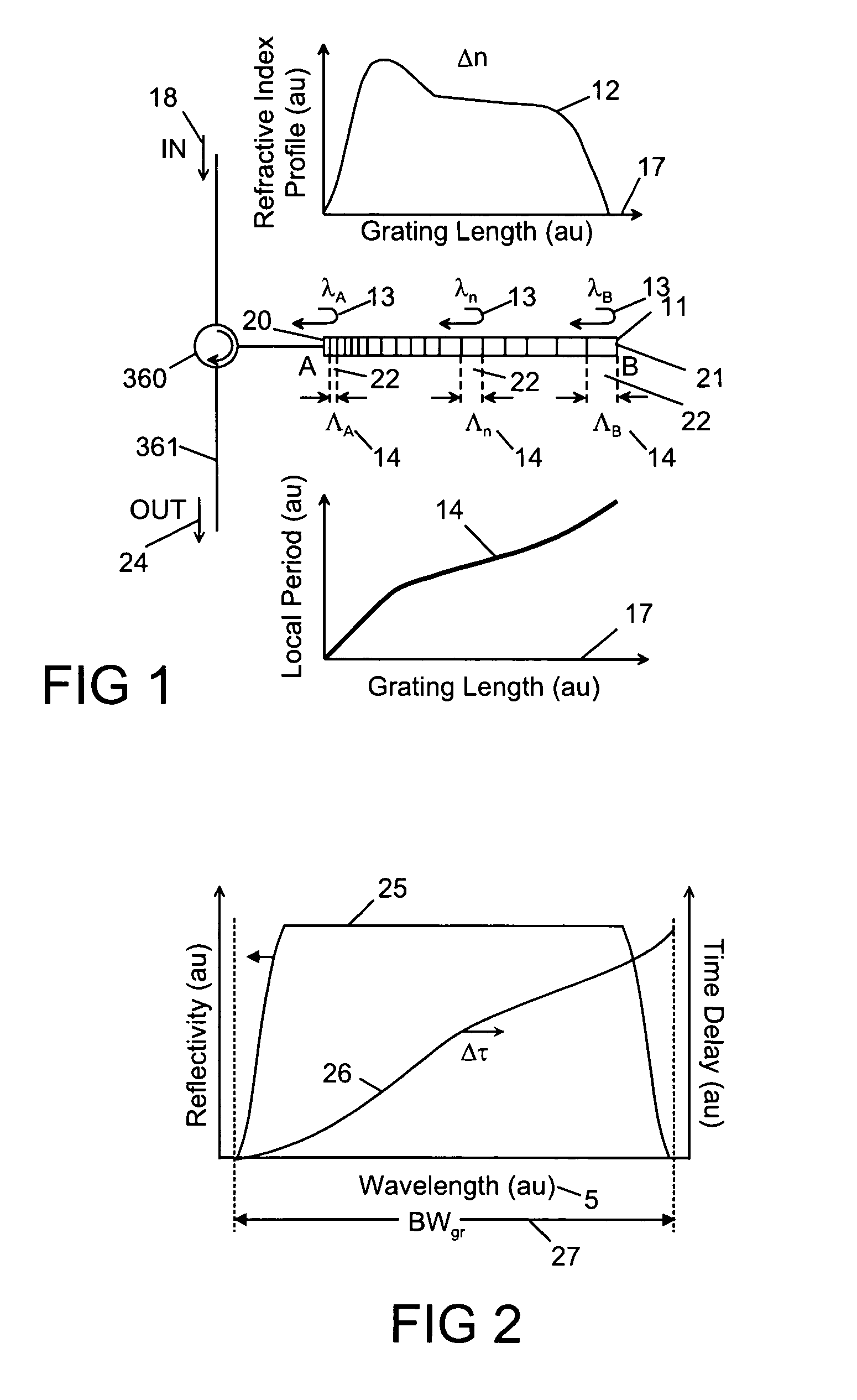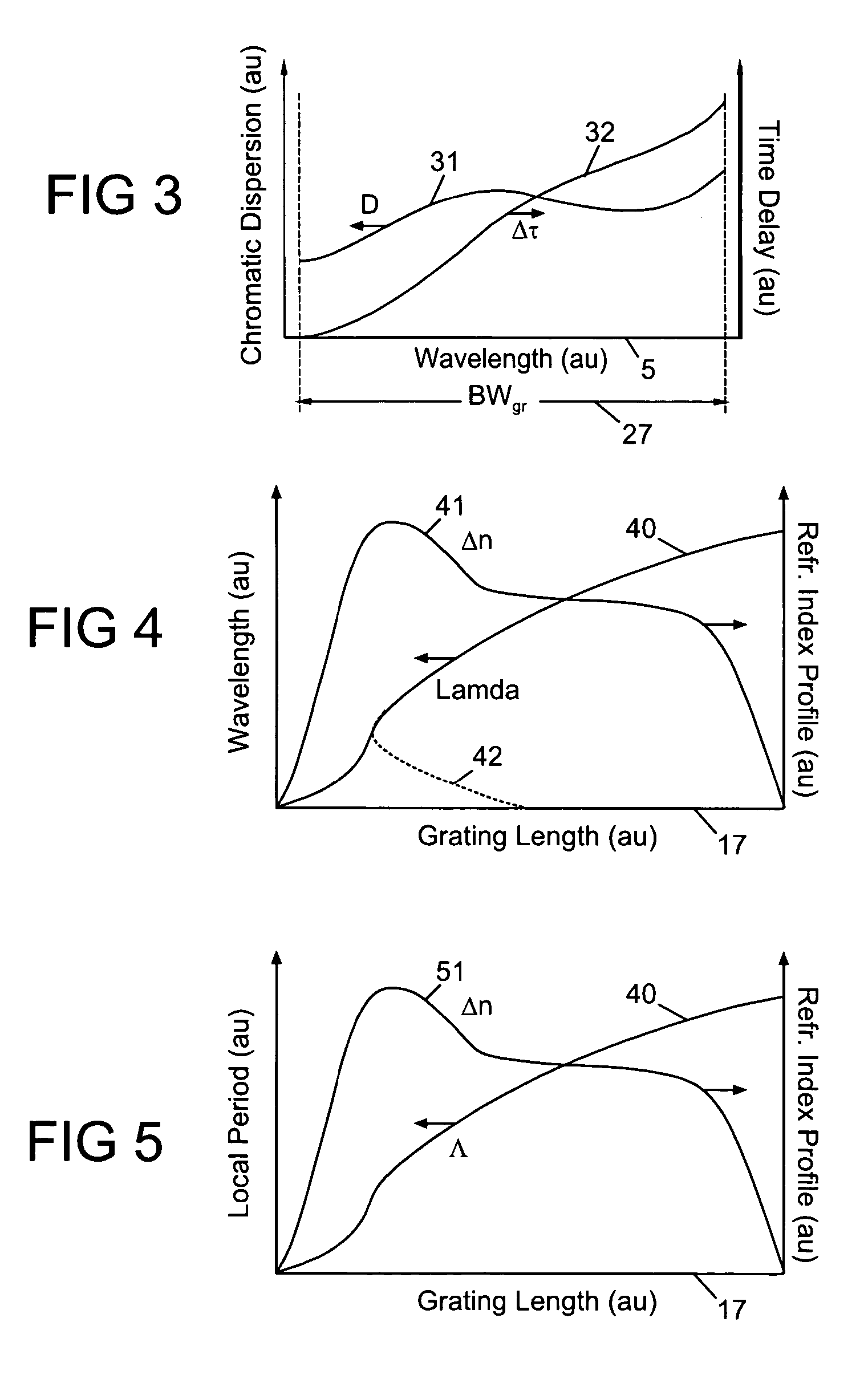Apparatus for dispersion compensating a signal that propagates along a signal path
a signal path and dispersion compensation technology, applied in the field of apparatus for dispersion compensation of signals, can solve the problems of not being normally thought of as useful and the conceptual difficulty of grating
- Summary
- Abstract
- Description
- Claims
- Application Information
AI Technical Summary
Benefits of technology
Problems solved by technology
Method used
Image
Examples
case 1
[0096] Two Unchirped, Pure 3rd-Order Dispersion Gratings
[0097]FIG. 22 shows the linear dispersion map 220 of the tuneable chromatic dispersion compensator module 210. When the channel bandwidth BWch is aligned (centred) with respect to both grating bandwidths BWgr, the linear dispersion at the centre of the channel bandwidth is zero. The chromatic dispersion tuning can be achieved by applying uniform perturbations, such as uniform temperature or strain, along the grating length. Such uniform perturbations result in a relative shift of one of the grating spectrum (e.g. grating#2—BWgr20) with respect to the channel bandwidth BWch by Δλ0. If without loss of generality we assume that grating#1 remains unchanged, the linear dispersion of grating#2 is given by D20(λ)=D2(λ−Δλ0).
[0098]The total dispersion DT(λ;Δλ0) 225 of the tuned DCM 210 is the sum of the two individual dispersions 221, 222, given by:
DT(λ;Δλ0)=D1(λ)+D20(λ)=D1(λ)+D2(λ−Δλ0)=b1Δλ0 (15)
[0099]From Equation (15), it can be see...
case 2
[0104] One Unchirped, Pure 3rd-Order Dispersion Grating and a Non-Linearly Chirped Combined 2nd+3rd Order Dispersion Grating
[0105]Another tuneable dispersion-compensation-module variant can be achieved by replacing one unchirped, pure 3rd-order dispersion grating, described in case 1, with a non-linearly chirped 2nd+3rd order dispersion grating (similar to ones used in prior art) in the apparatus shown in FIG. 21. FIG. 26 shows a schematic of the reflectivity 260 (left axis) and time-delay variation Δτ261, 262 (right axis) as a function of the wavelength. Δτ1 261 and Δτ2 262 refer to grating#1 and grating#2, respectively (see FIG. 21). The corresponding linear dispersion maps is shown in FIG. 27. The dispersion variation across the grating bandwidth is described by Equations (12) and (13) with the coefficients where a2≠a1=0 and b2=−b1.
[0106]When the channel bandwidth BWch is aligned (centred) with respect to both grating bandwidths BWgr, the total linear dispersion 271 at the centre...
case 3
[0112] Two Different Non-Linearly-Chirped, Combined 2nd+3rd Order Dispersion Gratings
[0113]The case of a tuneable DCM that uses two different non-linearly chirped gratings that show combined 2nd+3rd order dispersion will now be described. FIG. 31 shows a schematic of the reflectivity 310 (left axis) and time-delay variation 311, 312Δτ (right axis) as a function of the wavelength. Δτ1 and Δτ2 refer to grating#1 and grating#2, respectively (see FIG. 21). The corresponding linear dispersion maps 320 are shown in FIG. 32. The dispersion variation across the grating bandwidth is described by Equations (12) and (13) with the coefficients where a2≠a1≠0 and b2=−b1.
[0114]When the channel bandwidth BWch is aligned (centred) with respect to both grating bandwidths BWgr, the total linear dispersion at the centre of the channel bandwidth is D0=a1+a2. The chromatic dispersion tuning can be achieved by applying uniform perturbations, such as uniform temperature or strain, along the grating length....
PUM
 Login to View More
Login to View More Abstract
Description
Claims
Application Information
 Login to View More
Login to View More - R&D
- Intellectual Property
- Life Sciences
- Materials
- Tech Scout
- Unparalleled Data Quality
- Higher Quality Content
- 60% Fewer Hallucinations
Browse by: Latest US Patents, China's latest patents, Technical Efficacy Thesaurus, Application Domain, Technology Topic, Popular Technical Reports.
© 2025 PatSnap. All rights reserved.Legal|Privacy policy|Modern Slavery Act Transparency Statement|Sitemap|About US| Contact US: help@patsnap.com



